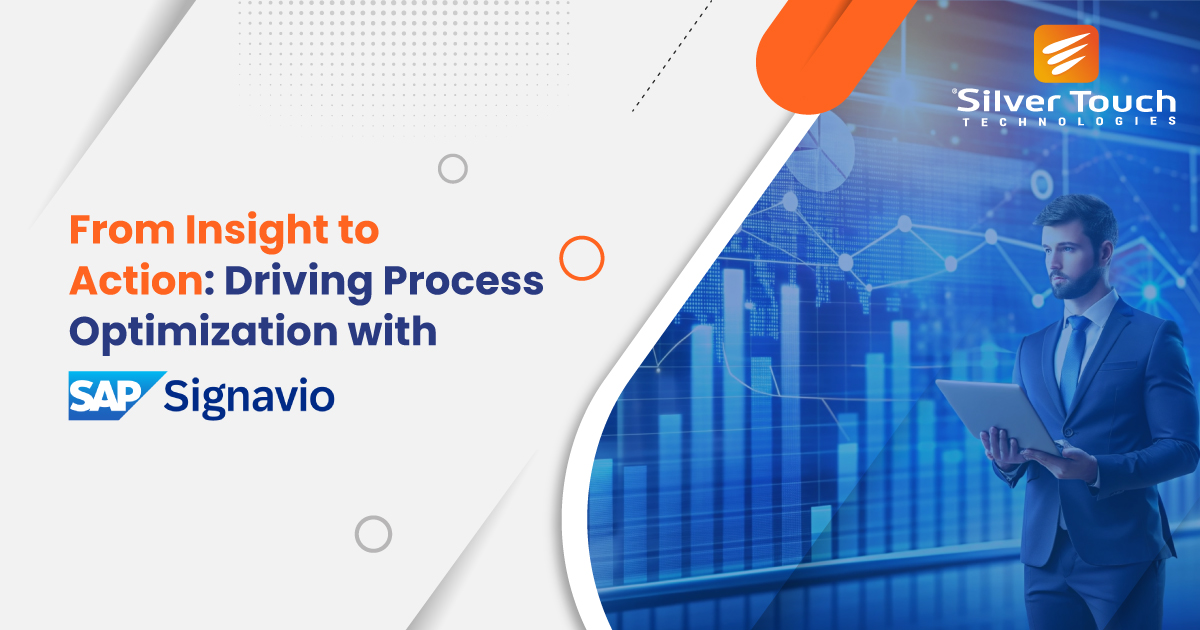Operational efficiency is the need of the hour in a fast-paced, digital economy. It gives a competitive advantage and contributes to achieving sustainable growth for the business. Modern enterprises tend to invest in business process transformation to achieve this objective, but struggle with fragmented processes.
The ability to move beyond automation to achieve continuous process improvement can help organizations handle this situation. It is also beneficial for reducing costs and enhancing customer experience. This is where the SAP Signavio Suite comes into play. It combines the power of process mining with collaboration.
This post discusses the features and benefits of SAP Signavio that convert process insights into measurable business impact. Before moving ahead, let’s understand the process optimization and some challenges companies face in achieving it.
Understanding Process Optimization
A recent McKinsey Report has revealed that businesses implementing process improvements can reduce operating costs by up to 30 percent in two years. Process Optimization is a systematic approach that focuses on analyzing, redesigning, and improving existing business processes. It is useful for making operations more efficient, effective, and adaptable. Process optimization focuses on maximizing value by reducing costs, time, and errors.
Effective optimization runs a continuous cycle of measurement and analysis for driving greater agility. However, it is essential to overcome some organizational and technical challenges to make process optimization and mining successful. The lack of visibility and data fragmentation are key challenges for it.
Other hurdles include resistance to change and defining KPIs to measure the impact on business goals. These challenges prevent companies from increasing business value by slowing down the process optimization. Here, a cloud-based SAP Signavio emerges as an advanced assistant.

Overview of SAP Signavio Business Process Transformation Suite
SAP Signavio is a comprehensive, cloud-based suite that gives modern organizations a true, end-to-end view of their business operations. It integrates robust Process Mining capabilities with in-built collaborative process modeling and customer journey mapping tools.
This solution uses data collected from various IT systems (like ERPs, CRMs, etc.) to automatically discover and visualize processes and their deviations. It serves as a single source of truth for all process-related insights to enable continuous process improvement.
The SAP Signavio suite has an integrated set of applications that work together to run the full lifecycle of process excellence. It takes care of every stage from discovery and analysis to modeling, collaboration, and execution. SAP Signavio moves beyond documenting processes to analyze their performance against business objectives.
Core Components of SAP Signavio
The SAP Signavio Suite empowers corporate users and IT teams alike to design future-state processes collaboratively. It has several advanced components, including process manager, process intelligence, journey modeler, and collaboration hub. Let’s understand their roles one after another.
- Process Manager
- Process Intelligence
- Journey Modeler
- Collaboration Hub
It is the central platform for collaborative process modeling and documentation. It keeps process knowledge consistent and easily accessible.
Process Mining empowers this component for using the event data. It is useful to reconstruct and analyze end-to-end process flaws from IT systems automatically.
This tool helps companies map and understand the customer or employee experience across different touchpoints. It also links process performance to experience data.
It serves as the social and communication layer for this business process transformation suite. It acts as a central repository where all employees can access, discuss, and be informed about changes.
All these components together drive process optimization effectively. Let’s dig in.
Read More: Essential SAP Business One Implementation Guide for Emerging Business
How SAP Signavio Drives Process Optimization
SAP Signavio offers a structured, data-driven methodology to empower organizations to achieve continuous process improvement across their entire value chain. It takes organizations through a following six-step journey ensuring business process transformation aligned with strategy.
- Discover and Visualize Processes
- Analyze and Identify Bottlenecks
- Design and Simulate Workflows
- Collaborate and Align Teams
- Implement and Monitor Changes
- Continuous Improvements with Real-Time Insights
Inbuilt Process Mining capabilities enable SAP Signavio to fetch log data automatically from your operational systems. It can reconstruct and visually map your processes exactly as they currently run.
Once processes are mapped, this suite uses Process Intelligence to analyze performance data. It can automatically highlight areas of delay, non-conformance, and waste. It indicates the root causes of inefficiencies and quantifies the financial impact as well.
Teams can use the Process Manager to design improved processes based on the insights gained collaboratively. Moreover, this platform enables you to simulate the impact of new workflows on key metrics before implementation.
The Collaboration Hub ensures that all stakeholders, from business users to IT, are on the same page. It facilitates communication, collects feedback, and builds organizational buy-in for the upcoming process changes.
Tools like SAP Build Process Automation can improve processes. SAP Signavio then continues to monitor the live execution of the new process, comparing its performance against the simulated expectations and KPIs.
This suite maintains a constant link between process models and live execution data to establish a Continuous Process Improvement loop. Moreover, real-time data feeds identify new deviations or emerging issues in ongoing optimization.
All these steps lead to significant business benefits and improved process optimization.
Key Benefits of Using SAP Signavio for Process Optimization
SAP Signavio can integrate data-driven process intelligence with collaborative modeling tools. This capability can drive business process transformation and offer significant benefits, including-
- End-to-End Visibility
- Faster Transformation
- Increased Efficiency
- Enhanced Collaboration
- Data-Driven Decisions
Signavio provides a single, objective view of all processes—from front-end customer interaction to back-end fulfillment. This detailed, cross-functional characteristic eliminates data silos and reveals hidden interdependencies.
SAP Signavio has the ability to discover, analyze, and simulate process changes instantly. This results in minimizing the time required for transformation initiatives. Teams can quickly validate improvements and accelerate timelines.
SAP Signavio drives operational efficiency by using process mining to identify and eliminate waste and unnecessary steps. This optimization results in reduced cycle times and operational costs with higher quality output.
The Collaboration Hub ensures all employees remain on the same page, creating a shared understanding of process goals and changes. This cross-team alignment breaks down organizational barriers and nurtures a culture of improvement.
SAP Signavio gives verifiable facts using real-time operational data to quantify the impact of every process variation. This accuracy maintains the effectiveness of process optimization and leads companies to make data-powered decisions.
However, it is essential to integrate SAP Signavio properly into the existing system to leverage these benefits.
Integrating SAP Signavio with Your Digital Transformation Strategy
SAP Signavio acts as the essential foundation and compass for any successful digital transformation (DX) initiative. Traditionally, DX projects focus heavily on deploying new technologies like cloud ERP (e.g., SAP S/4HANA) or advanced automation. However, at times, these technologies fail to address the underlying, inefficient processes. Signavio solves this by giving vital process intelligence before and during the technology rollout.
Process Mining and the Journey Modeler assist organizations to gain an objective, data-driven understanding of their current state and customer requirements. This understanding is necessary to define a clear, optimized “to-be” process blueprint that maximizes the value of new technologies.
Furthermore, this alignment ensures that every component of the business process transformation strategy remains validated as a high-impact business process. This makes the transformation faster, less risky, and capable of delivering measurable ROI.
Here, it is necessary to choose a reputable and official SAP Partner to integrate this solution effectively into your existing system.
Read More: Why Growing SMEs Choose SAP Business One for Scalable Operations
Getting Started with SAP Signavio
Starting your journey with SAP Signavio is a systematic process that delivers quick, measurable returns by focusing your optimization efforts. It moves away from broad, high-level transformation to targeted improvements by following the steps, including-
Assess Current Business Processes
It starts with using the Process Mining capabilities of SAP Signavio to ingest data from your existing IT systems. This step automatically visualizes the true “as-is” process flows and provides an objective, data-backed baseline.
Identify High-Impact Areas
You can leverage Process Intelligence to analyze the process maps and metrics. It is useful for identifying the most significant bottlenecks and points of waste automatically. This can help you find the areas of improvement as well.
Deploy SAP Signavio Tools
You can set up the core SAP Signavio suite for future-state design, analytical insights, and engage stakeholders while creating transparency. Tools like the Collaborative Hub and Process Manager can help you achieve process optimization goals quickly.
Train and Engage Business Users
It is imperative to give thorough training to key business process owners and end-users. The aim of training should remain on the reasons for making changes in the process to ensure that end-users become active participants.
Measure Outcomes Through KPIs
It is necessary to establish clear Key Performance Indicators (KPIs) according to your business goals. You can use SAP Signavio to monitor all the implemented processes as per these KPIs effectively.
These best practices can help you make the most out of the SAP Signavio suite.

Concluding Remarks
SAP Signavio is a robust solution for achieving true Business Process Transformation. It leverages Process Mining and Process Intelligence to provide objective, data-driven insights into inefficiencies. Organizations can use these insights to design, simulate, and implement optimized workflows collaboratively for generating lasting value. However, it is essential to select the right SAP Partner to drive operational excellence using SAP Signavio solutions.



